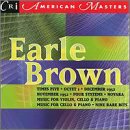| All Artists: Earle Brown, Soyer, Tudor, Dougherty Title: Times Five, Octet I, December 1952 & Other Works Members Wishing: 1 Total Copies: 0 Label: Composers Recordings Original Release Date: 1/1/1950 Re-Release Date: 4/25/2000 Album Type: Import Genre: Classical Styles: Chamber Music, Historical Periods, Classical (c.1770-1830) Number of Discs: 1 SwapaCD Credits: 1 UPC: 090438085120 |
Search - Earle Brown, Soyer, Tudor :: Times Five, Octet I, December 1952 & Other Works
 | Earle Brown, Soyer, Tudor Times Five, Octet I, December 1952 & Other Works Genre: Classical
|
Larger Image |
CD Details |
CD ReviewsPluck. Blip. Silence. Douglas T Martin | Alpharetta, GA USA | 02/10/2003 (5 out of 5 stars) "The recently-deceased Earle Brown was one-quarter of the four composers dubbed 'The New York School' back in the 1950s. John Cage, Morton Feldman, and Christian Wolff (the only surviving member) have had higher profiles what with the compositions of Cage and Feldman being extremely well documented and Wolff recently recording with Sonic Youth and the John Zorn 'Downtown' crowd (check out the "Burdocks" CD on Tzadik for the results).Brown was one of the first composers - if not the first - to use graphic notation, a method by which the musical score consists of graphs, diagrams, pie charts or whatever to convey to the musician what sounds they should be producing (ie: "Look at this picture of a Fourier Transform overlaid with a graph of the Standard and Poor's Index for the past five years and play what you think it means"). The piece where this method was first used was "December 1952" written in 1952 and interpreted on this recording by pianist David Tudor.Brown's "Octet for 8 Loudspeakers" is a 3+ minute tape collage composition, similar to Cage's (in)famous "Williams Mix" (Cage & Brown worked together on their tape compositions). "Octet" is a series of blips, bloops, and squawks broadcast over eight loudspeakers. To get the full effect of this octophonic work it is best to listen to it through headphones. Actually the whole CD is best heard through headphones so that the listener can pick up the subtle nuances of the compositions without being subjected to repeated questions like "what the ...are you listening to?" and "will you turn that off before you drive me ... nuts?".The two ensemble compositions, "Times Five" and "Novara" are similar to Feldman's compositions in that they both use a scarcity of notes and a lot of silence; they are also similar to Cage's "Number" compositions in terms of the seemingly randomness of the generated sounds. In case soundbytes are not available, here is a transcription of either composition - it doesn't matter which one:Pluck. Blip. Silence. Strum. Silence. Overtone. Scrape. Minor Pentatonic. Silence. Blip/Scrape. Chair Creak. Back to coda.If you found this page you were either searching for Earle Brown or Steve Earle. If Steve Earle was your goal, then keep looking. But if you were looking for Earle Brown then you are probably already familiar with Cage, Feldman, Wolff, Stockhausen, and the like. Earle Brown's music is from the same genre - same Jello, different mold.This CRI recording is a good introduction to Earle Brown's music because it offers many different styles and realizations: solo, duo, ensemble, acoustic, electronic, old, and new. In fact, it's a good introduction to the 'New York School' sound itself.Once more, with feeling: Pluck. Blip. Silence. Strum. Silence. Squeak. Scrape. Tritone. Silence. Honk/Scrape. Sniff. Back to coda."
|

 Track Listings (10) - Disc #1
Track Listings (10) - Disc #1